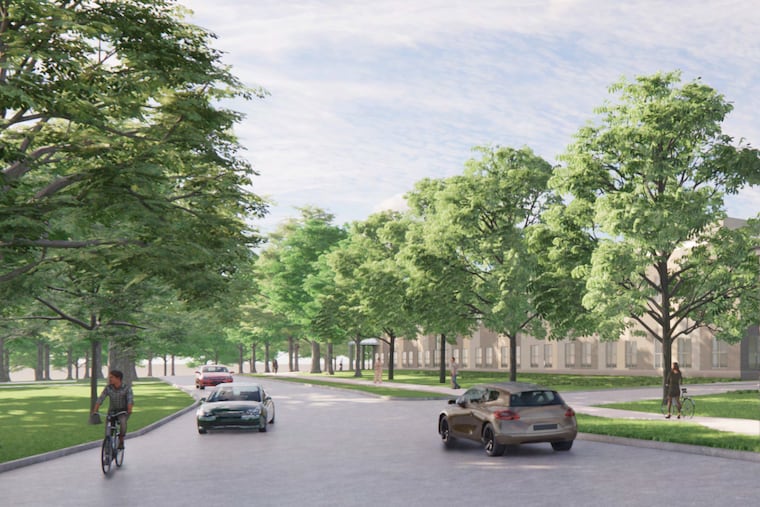Demolition of historic building approved for new health center in Northeast Philly
Philadelphia's health commissioner talks to The Inquirer about the location of a new health center for Northeast Philadelphia after prevailing at a Historical Commission meeting Friday.

A proposal for a new public health center in Northeast Philadelphia moved a step closer to fruition on Friday as the Historical Commission voted 7–4 to approve the demolition of a historic building on the Friends Hospital campus to make way for the new medical structure.
The vote comes after a yearslong quest by the Philadelphia Health Department to find new locations for centers in Northeast Philadelphia, where demand for public health services has skyrocketed and wait times at the nearby Health Center 10 have ballooned.
In 2020, the Historical Commission questioned the proposal for the Friends Hospital campus, and the health department sought a new location. But they say the search was fruitless.
“We were unable to identify an additional site that provided the large space, accessibility, parking, and visibility of the proposed site on the Friends campus,” Cheryl Bettigole, Philadelphia’s health commissioner, said in a statement to The Inquirer after the meeting.
The Friends Hospital location has been criticized because of the potential dangers to those accessing the site by public transit. The current layout of SEPTA bus stops would require patients to cross the 12-lane Roosevelt Boulevard — one of the most dangerous roads for pedestrians in the city.
As a compromise, the Health Department is also opening a new center next to the Frankford Transportation Center, but it will have a much smaller capacity than its counterpart at the Friends Hospital campus.
“We understood that there was great community interest in a city health center at the Frankford Transportation Center,” Bettigole wrote. “Based on a deeper understanding of that interest and the growing poverty and health-care needs in the lower Northeast, we then proposed to build two health centers rather than one.”
The Health Department’s analysis found that 20% to 24% of patients would arrive at the boulevard location by transit. Almost 30% of the households in the zip code that contains the Friends Hospital campus have no access to a vehicle, according to the most recent Census data.
Newly arrived refugees and immigrants, whom the department specifically hopes to serve at the site, are less likely to have access to a car or even a driver’s license. Overall, lower-income residents are much more likely to rely on city services for health care — and are much more likely to not own a car.
The Health Department argues that new safety improvements on the boulevard will ameliorate pedestrian safety concerns on the 12-lane road. A $78 million federal grant is paying for modernization of traffic signals, reconfiguration of intersections, and installation of pedestrian refuge islands. Directly in front of the campus, Bettigole noted, will be a new direct bus route and an “enhanced bus shelter,” scheduled for roll out in 2025.
“The city is investing significant resources in the safety of the boulevard,” wrote Bettigole. “The health center will sit near the entrance to campus at a traffic signal where the SEPTA stop is, helping to ensure that pedestrians who need to cross the boulevard do cross at the light.”
Preservationists, meanwhile, have critiqued the site because it will disrupt the historic campus originally established as the Friends Asylum for the Relief of Persons Deprived of the Use of their Reason in 1813. The proposal will result in the demolition of an almost 170-year-old building, Lawnside, that once served as the superintendent’s residence.
Some members of the Historical Commission asked whether the building could be incorporated in some way.
“I understand every minute counts in medicine, but we could at least take a look at those things and see what we can try to come up with [to preserve the] building,” said Robert Thomas, chair of the Historical Commission. “It could be put to a good use and help to provide a welcoming environment, and provide a link to the history.”
But supporters of the location argue that the current location, which is at the mouth of the campus, requires the least amount of walking for those who do take the bus.
As for a site away from the campus itself, the Health Department says there is no other place a new center of this magnitude can be located in the Northeast. That’s not because other property isn’t available, but because the political hurdles to placing a center at other locations are too high, according to former health commissioner Donald Schwarz.
“The NIMBY issues in the Northeast, the Councilpeople issues in the Northeast, and [property] owners of the Northeast’s lack of understanding or willingness to have a public health center make it impossible,” Schwarz, who served under Mayor Michael Nutter, told the Historical Commission.
Former Councilmember Bobby Henon and Councilmember Brian O’Neill created a zoning overlay that bans all medical offices from their districts as a means to stymie new methadone clinics. Those two districts cover much of Northeast Philadelphia.
Notably the Frankford Transportation Center and the Friends Hospital campus were in former Councilmember Maria Quiñones Sánchez’s district, who expressed skepticism of the Friends Hospital location and championed a larger Frankford Transportation Center location. The district is now represented by Councilmember Quetcy Lozada, who supports both proposals.
But Bettigole downplayed the zoning overlays prohibiting medical offices in much of the Northeast as a determining factor at the site.
“The lack of a site that had all the necessary characteristics was the limiting factor,” Bettigole said. “Had there been a perfect site in the area with highest need in a Council district with such a zoning overlay, we would have gone to the Council person to ask for their assistance.”